These seem very similar as both diffusers and humidifiers admit a mist into the air. There is also tremendous overlap in how they work to transfer a liquid into the air. However, choosing a diffuser vs humidifier is helped by the fact that they are both quite specialized for their different functions. They also both have different health implications.
As a general rule diffusers transfer mainly essential oils into the air and humidifiers mainly transfer water into the air. Use a diffuser alone when the relative humidity is above 30%. When the relative humidity is below 30% use a humidifier designed to take essential oils or any humidifier with a diffuser.
There will be a few areas where the winter is very mild and the air is moist even in winter with a relative humidity of 30-50%. In these areas youwill probably not need a humidifier. In most areas you will need a humidifier in winter and in desert areas may even need one year round.
So how do they work? What are the differences? Which is best? Let’s consider humidifiers and diffusers and then compare them.
Mechanism of Diffuser vs Humidifier-Two Basic Ways of Getting Liquid Into The Air for Both
Evaporation
Humidifiers and diffusers can use evaporation to get pure water vapor into the air. In a sample of water, different water molecules have different energies. Occasional water molecules have enough energy to escape from the surface of the water into the air. This is how evaporation occurs. In this situation, single molecules are leaving the surface of the water and they are far too small to take any impurities or minerals with them.
Throwing off Droplets Into the Air
The other way that humidifiers can send water into the air is by creating water droplets which are thrown into the air.
The problem with devices that send water droplets into the air is that impurities in the water that forms the droplet will go with the droplet into the air. You may then breathe in these droplets with impurities. The impurities can include minerals, which when the droplet settles on your furniture or floor and dries out leaves a white deposit. This is a particular problem in hard water areas, as there are more minerals in the water.
The other sorts of impurities can include biological agents, such as bacteria or fungi growing in the water in the humidifier or diffuser. It can also include allergens that have got into the water from the air flow through the humidifier. These can then be sent into the air in droplets and breathed in by anyone in the room but are a particular problem for asthmatics. This can rarely cause widespread inflammation in the lungs “Humidifier Lung“.
There is also a health problem with minerals in the water. There is a case report of the lungs of a young child being damaged by an ultrasonic humidifier. Also, in a laboratory study particles of minerals were seen in the lungs and there were some associated changes in cellular function in the lungs but no severe inflammation. So it was concluded that only distilled water should be used.
In addition to using distilled or at least filtered (not simply jug filtered) water in the humidifier, having a regular and frequent cleaning schedule is needed to prevent the above problems.
Humidifiers
Humidifiers are a great help in a dry climate and especially in the winter when the humidity is lower. They can help to prevent dry skin, cough and even nose bleeds. There are several types of humidifiers that you could choose they all introduce moisture into the air but each has significant pros and cons.
Humidifiers That Heat the Water-Potential Danger For Children or Pets But Quiet
“Warm Mist Humidifier” = Steam Vaporizer = Steam Humidifier
Warm mist humidifiers use heating elements to form steam, which escapes from the top of the humidifier. They may have a small fan to help the steam escape. So they are quieter than evaporative humidifiers.
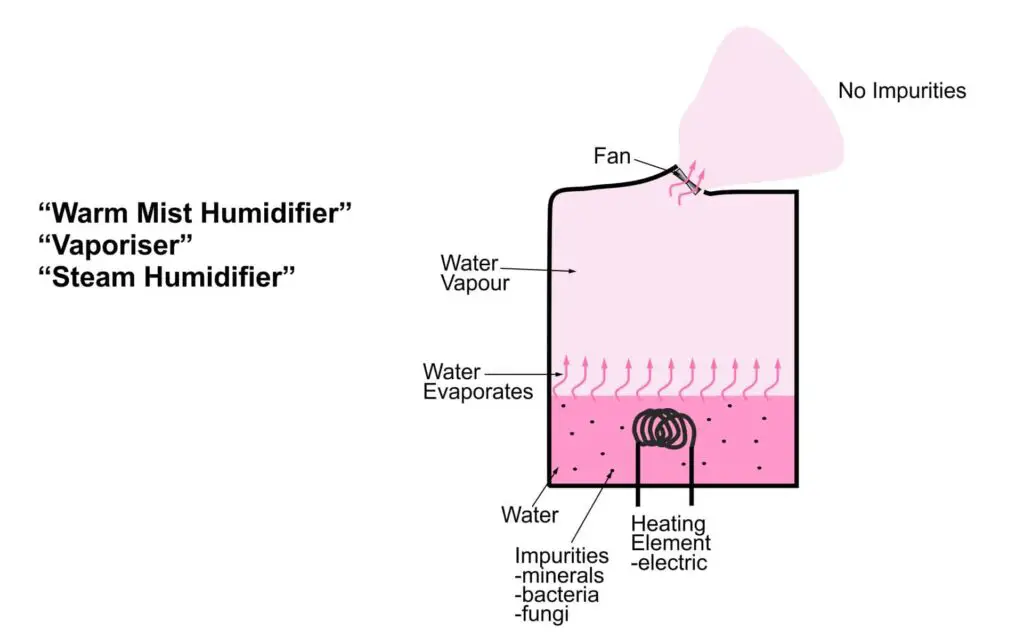
They need to have a reasonably sized water tank, a 1 gallon tank will last 10 hours or so. Because they have a heating element, they need to have an automatic cut out to switch off when the water no longer covers the heating element.
Humidifiers that heat the water are not so suitable for homes with young children or ground-level pets. The steam from a warm mist humidifier or vaporizer may scald a child if they explore the steam coming from it.
Cold Water Humidifiers-Potential for Bacteria and Fungi to Grow in the Humidifier Water
Humidifiers that Use Cold Water and Produce Water Droplets-
1) Ultrasonic Humidifier
These use ultrasound to agitate the water so that small drops are jettisoned into the air as a fine mist. The ultrasound is a very high frequency wave created by applying an electric current to a crystal. The electric current causes ultrasonic vibration in the crystal which is connected to a plate, which then makes a larger area of water vibrate this creates air cavities and throws off droplets.
An ultrasonic humidifier is the quietest type of humidifier, usually not audible even in a quiet room. Humans can hear sounds with a frequency up to 20,000Hz, dogs up to 40,000Hz and cats up to 60,000Hz. These purifiers vibrate the water at 1-2 megaHz so even your pets will not be able to hear them.
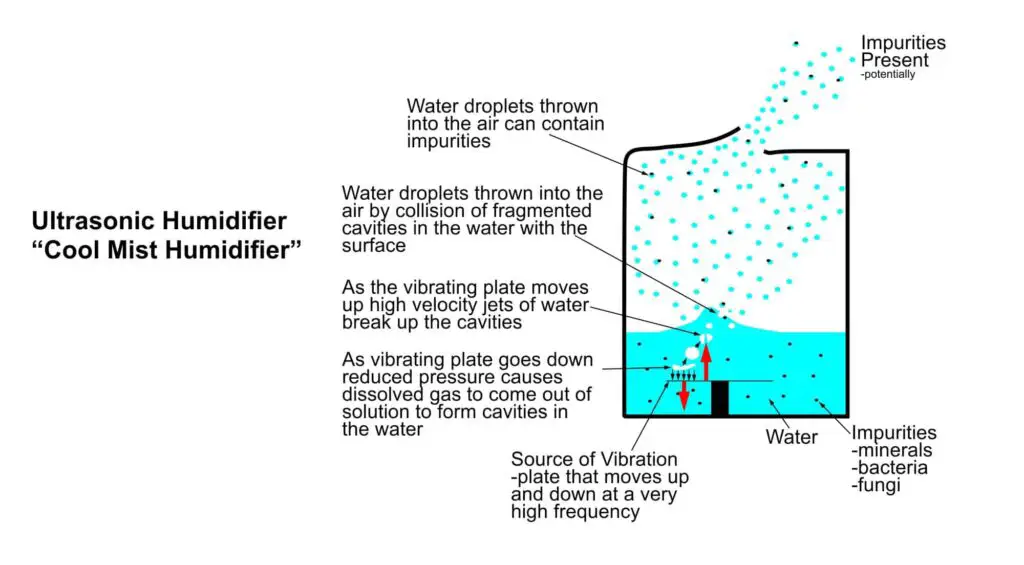
The problem with ultrasonic humidifiers is that they work by splashing water droplets into the air. This means that any mineral impurities, bacteria or fungi in the water will end up in the air. The water droplets when they settle on everything in the room can dry to leave a white deposit of the minerals behind.
Also, the bacterial or fungi in droplets in the air can be breathed in by anyone in the room. Some manufacturers include filters to remove minerals and ionized silver to prevent growth of bacteria.
The best approach to preventing the growth of bacteria and fungi in addition to cleaning the humidifier regularly is to use distilled water. This is produced by evaporation and so has no minerals initially so if microorganisms do land in the water when it is still clean they cannot grow.
Some models are relatively small and can be used as tabletop humidifiers.
2) “Air Washer” =Impeller Humidifier = Cool Mist Humidifier
A cool mist humidifier also produces water droplets and so has the same problems with anything in the water in ending up in your lungs or spread over the room.

The name is misleading, although these washers do spray water through the air this will not reduce particle pollution in the air sufficiently to protect health.
Humidifiers that Use Cold Water and Do Not Produce Water Droplets-
Evaporative Humidifier = “Wick Humidifier”
In an evaporative humidifier, air is blown through a wick filter that is soaked with water. The water evaporates into the air to increase the humidity of the air.

The best humidifier depends on the circumstances. For those without ground level pets or children, including grandchildren, then a warm mist humidifier is best as there is less scope for bacteria and fungi growing in it. For those with children an evaporative humidifier is best.
For more detail on humidifiers please see this post.
Diffusers
Some people understandably love the smell of essential oils which can also be used for aromatherapy. You need a diffuser to get the oils into the air. The ultrasonic diffuser and nebulizing diffuser both create tiny droplets. The heat diffuser and evaporative diffuser release molecules rather than droplets into the air.
The various types of essential oil diffuser are-
- Ultrasonic diffuser-pure essential oils are added to the water in the diffuser. The ultrasonic technology consists of a vibrating plate in the liquid which produces ultrasound. This causes small droplets of the mixture to enter the air as mist (please see the diagram above) explaining ultrasonic humidifiers which shows this mechanism).
- Nebulizing Diffuser-use an atomizer to create a spray of fine droplets of oil which are distributed into the air.
- Heat Diffuser-use heat to evaporate essential oils into the air. Sometimes these use heat from a candle but this will increase particulate pollution in the air very significantly and so it is better to use an electronic version.
- Evaporative Diffuser-the essential oil is put on a pad and air is passed over the pad to help the oil diffuse into the air.
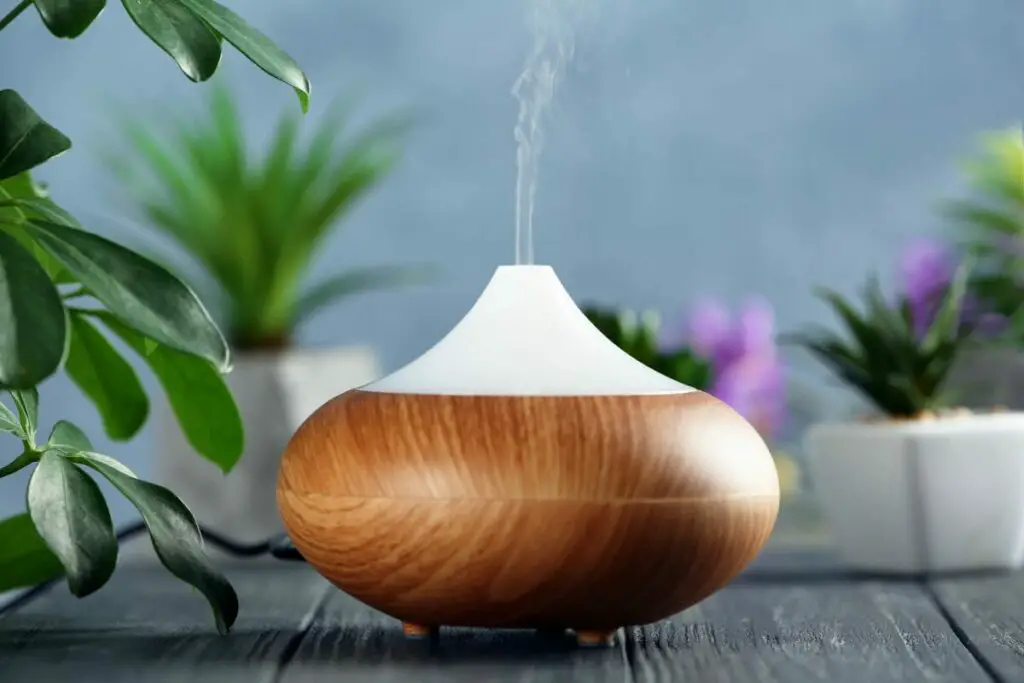
Any of these can be used as an aromatherapy diffuser.
Only the ultrasonic diffuser is likely to add a significant amount of water to the atmosphere.
An essential oil diffuser is really a specialized device designed to get as much essential oil into the air with as little water as possible.
Differences Between Diffusers and Humidifiers
Here is a table of the difference between a diffuser and humidifier-
| Feature | Diffuser | Humidifier |
|---|---|---|
| Volume of Water Held in Appliance | Standard 300ml (up to 2000ml 0.5gallons) | 4000ml Standard (up to 10000ml 2.6 gallons) |
| Volume dispersed into the air per hour | 1.5-60ml/hour | 200ml-400ml/hour |
| Power Consumption | 12-25 watts | 30 Watts (Warm mist 300-400 Watts) |
| Mechanism of Action | ||
| -ultrasonic | Yes | Yes |
| -evaporation-airflow over wick saturated with water/essential oil | Yes | Yes |
| -evaporation by heat | Yes can be via candle/heating element | Yes |
| Noise | Quiet 30db | Quiet 30db except “Air Washer” Type |
| Size | 4″ x 4″ x 5.5″ (Large model 7″ by 6″ wide) | 11″ x 8″ x 5″ |
| Weight | 0.5-1lb | 3-5lb |
| Cost | $15-39 | $30-140 |
Cross-Over Appliances-Humidifiers Built to Take Essential Oils
The problem with putting essential oils into a humidifier is that they can corrode the plastic of the water reservoir and gum up the motor of any fan. By designing the machine differently there are ways of overcoming these problems and there are some humidifiers that are especially built to take essential oils. You have to look for this being explicitly stated in the product description.
For instance, the PureGuardian H5175W 2-Gallon Top Fill Cool Mist Humidifier has a tray on the wall of the inside of the humidifier in which there is a pad that essential oils can be put.
Differences in Health Effects of a Diffuser vs Humidifier
There is better evidence for positive health effects with a humidifier than a diffuser with essential oils.
Health Benefits and Problems With Humidifiers
Benefits
Fewer problems with dry skin, dry eyes, and nose bleeds. There is evidence that they help asthmatics breathe better when exercising. There is also evidence of a reduction in the severity of infection at normal humidity levels.
Problems
One problem is that if the humidifier is not properly maintained then bacteria and fungi can grow in the water and the humidifier then disperse them into the atmosphere. Also those type of humidifiers that cause water droplets to be injected into the air such as ultrasonic humidifiers will take any impurities such as minerals that are in the water and spray them into the air. So if distilled water is not used with the types that produce droplets there is the potential for inducing respiratory problems as outlined above.
Health Benefits and Problems With Diffusing Essential Oils
There are only two essential oils that have reasonable evidence of effectiveness. Peppermint oil for headaches and lavender essential oil for sleep.
Peppermint Oil
Peppermint oil taken by mouth will help with some forms of abdominal pain. Peppermint oil can relieve the symptoms of a headache if applied directly to the skin.
Regarding the inhaling of peppermint oil, a review of multiple studies showed there was no definite effect on post-operative nausea. Another study showed a reduction in the nausea from chemotherapy. One study showed a decrease in sleepiness with peppermint in the air.
Specific Groups That Should Avoid Inhaling Peppermint Oil
- People on some common medications. Aromatherapy with peppermint oil can inhibit an enzyme system in our bodies that breaks down many medications, CYP3A4. So if you are on a medication which this enzyme system breaks down and you inhale peppermint oil vapor the plasma level of the medication will tend to rise. So you or anyone else inhaling the peppermint oil could be effectively overdosing on your/their medication. This affects quite a few common medications.
- People with G6PD deficiency-a genetic enzyme deficiency that leads to the breakdown of red blood cells in response to certain stresses/exposures to compounds.
- Children, babies and pregnant women
Peppermint oil can be toxic for pets including cats and dogs.
Lavender
Lavender may reduce mild anxiety to a similar extent that a small dose of lorazepam will. It also changes the brain activity as shown by brain scanning. It has mildly anticholinergic properties, that is, it inhibits neurotransmission from brain cell to brain cell with one particular very common transmitter-acetylcholine. Medication with this effect, that is inhibiting the interaction of neurons, has over years has been associated with an increased risk of mild cognitive impairment and dementia.
However, there is no proof that lavender increases dementia, possibly because there have not been any long-term studies yet. Lavender also reduced a marker of genetic activation associated with neuronal activity. There are also possibly beneficial effects of lavender, it is antioxidant. It stimulates dopamine, and GABA neuronal signalling and inhibits histamine release ie it also modulates other neurotransmitters. Anticholinergic effects seem to be central to its action, however.
Brain scans have shown that lavender increases activity in some areas of the brain and reduces activity in other areas. Lavender aromatherapy also altered the EEG-the electrical activity of the brain.
Short-term studies on thinking ability, cognitive function show impairment of memory or no change and on arithmetic reasoning a reduction, no-change or an improvement. So no definite conclusion can be reached regarding short-term effects on thinking ability.
Lavender increased appetite and body weight in rats when they took lavender orally. It also decreases fat break down and heat production again, potentially increasing weight gain. In addition, it has estrogenic and anti-androgenic activity. When taken orally (which you should not do with the essential oils that you buy) there were slightly more adverse events and lavender group–largely due to infections.
Scientific studies have indicated that lavender may also have some analgesic (pain relieving) properties due to its effect on opiate pathways. However, anticholinergic effects were also found to be important for its analgesic effect. Another study indicated that lavender alleviated the anxiety associated with pain but not the experience of the pain itself.
So lavender definitely affects brain function, the long-term effects of which are unknown. So it would seem reasonable that no one should be exposed to long-term lavender exposure without their informed consent. It may be best to avoid its use in homes with children as their brains are developing and so may be more vulnerable and also they cannot give their consent. It is also probably best to avoid its use in areas with pregnant women.
General Concerns With Essential Oils
Phenolic compounds in essential oils can irritate the airways in the lungs, particularly in babies. Terpenes in essential oils make the function of airways in the lungs worse in both normal people and asthmatics. So as a general rule asthmatics should not be exposed to diffusers.
The oils that you breathe in will be able to reach the deepest air sacs in your lungs where the oxygen enters the bloodstream. So the essential oils will be able to reach every organ-your brain, heart, bone marrow…. Some essential oils, although not necessarily the ones that you may buy have been shown to damage white blood cells. The amounts that enter your bloodstream will probably be small but the exposure may be over a long time.
So it would seem best not to use a diffuser in a home with a pregnant woman, baby or young children.
In a systematic review of case reports and case series, the most often occurring adverse effect was dermatitis from contact with the skin. The most common essential oils responsible for adverse effects were lavender, peppermint, tea tree oil and ylang-ylang. Other studies have found eucalyptus also to cause a significant proportion of adverse effects.
Essential oils should not be ingested orally and the most common causes of poisoning with essential oils are drinking them, mistaking them for medication or by inquisitive children. Approximately 50% of cases of inadvertent poisoning by essential oils are in the 1 to 4-year-old age group. There have been very rare fatalities, so essential oils should be stored separate from medication and out of the reach of children.
Dealing With Odors-Diffuser vs Humidifier
The most effective strategy is to remove the source of the smell. For instance if it is due to mold deal with the dampness in your home so that mold cannot grow. This will stop you being exposed to mold spores as you will be if you just use a diffuser to mask the smell. You could paint the walls and ceiling of a room and replace the flooring. However it is not always possible to remove a smell.
If you are dealing with a smell, then a humidifier will not help but essential oil in a diffuser will mask it. However, from a health point of view, rather than add additional chemicals to the air, it would be better to use an air purifier with a high volume carbon filter to remove the chemical from the air that is causing the odor. The air purifier will then also remove fine and ultrafine particles, making the air healthier.
Diffuser vs humidifier-which is best?
As a whole, a humidifier is better than a diffuser when the humidity is low. It will add much more water vapor to the air and raise the humidity and some humidifiers are designed to take essential oils. However, at times of the year when humidity is high, usually in the summer months if you want to add essential oils to the air, a diffuser is the only appropriate choice. This is because you do not want a humidifier to make the high humidity even worse.
For those who want to use essential oils, a humidifier in the winter and a diffuser in the summer will be best.
You could even run both at once-they are fairly cheap. This will give you independent control of the humidity and the amount of essential oil in your air.
Related Questions
See Also
How many drops of essential oil to add to a diffuser? -in this article I discuss this and some health issues.
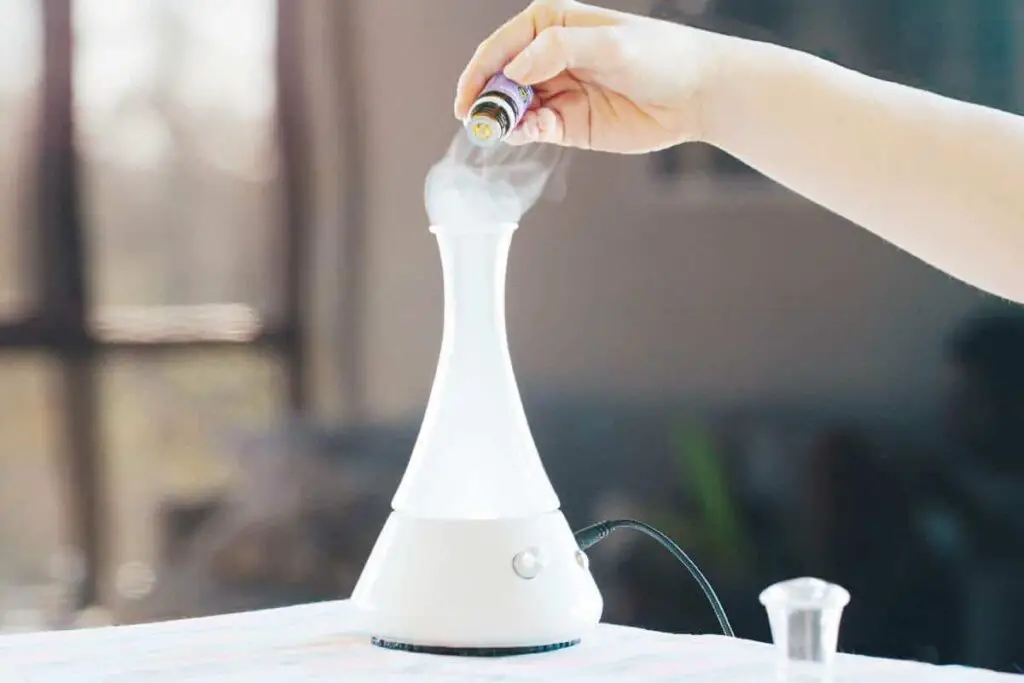
Can I use essential oils with an air purifier?-in this article I discuss various problems with using the two together and how to overcome these
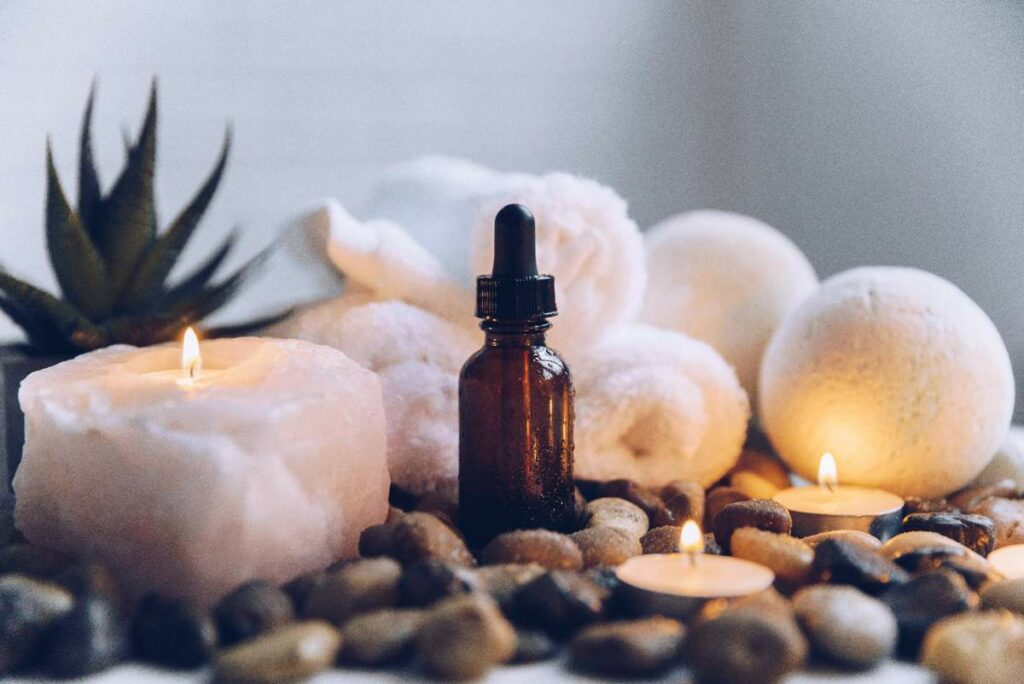
Whole House Humidifier-7 Reasons It Is So Much Better Than Several Portable Units

Different Types of Humidifiers-Only 1 Type Will be Perfect For You

Do Humidifiers Help With Asthma?


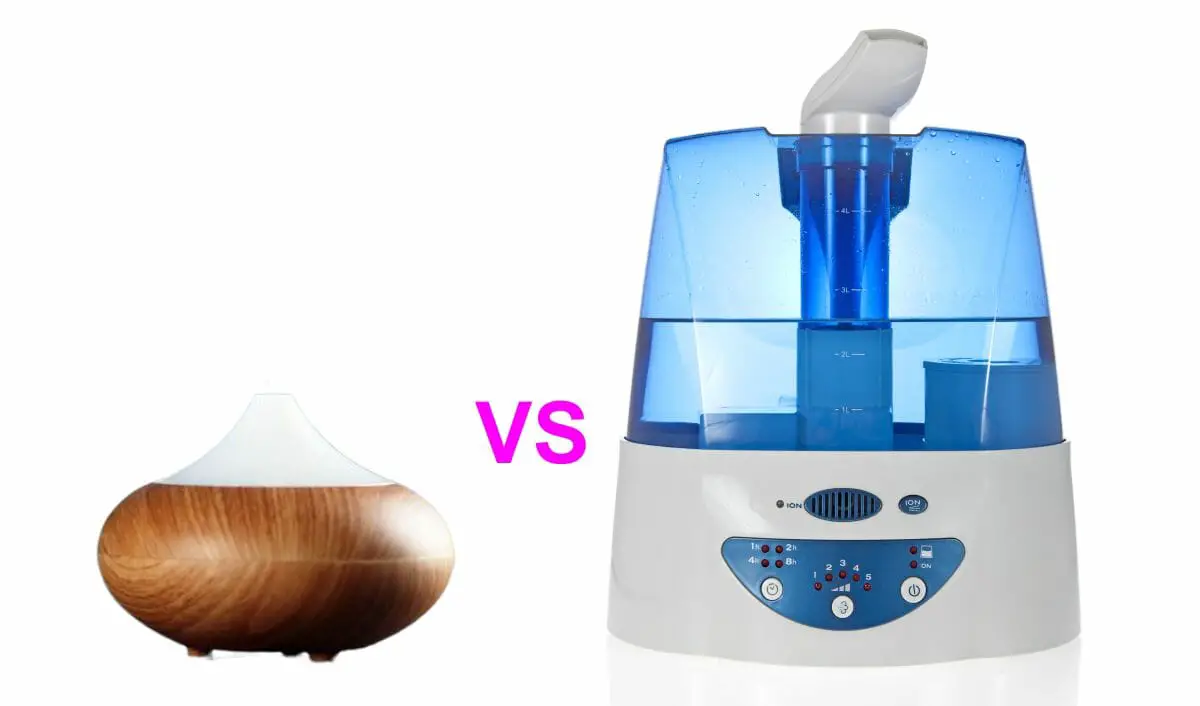
2 responses to “Diffuser vs Humidifier?-Surprisingly and Frustratingly You Need Both!”
Hello There. I discovered your weblog using msn. That
is a very well written article. I will be sure to bookmark
it and return to learn more of your useful info.
Thank you for the post. I will certainly comeback.
Thank you